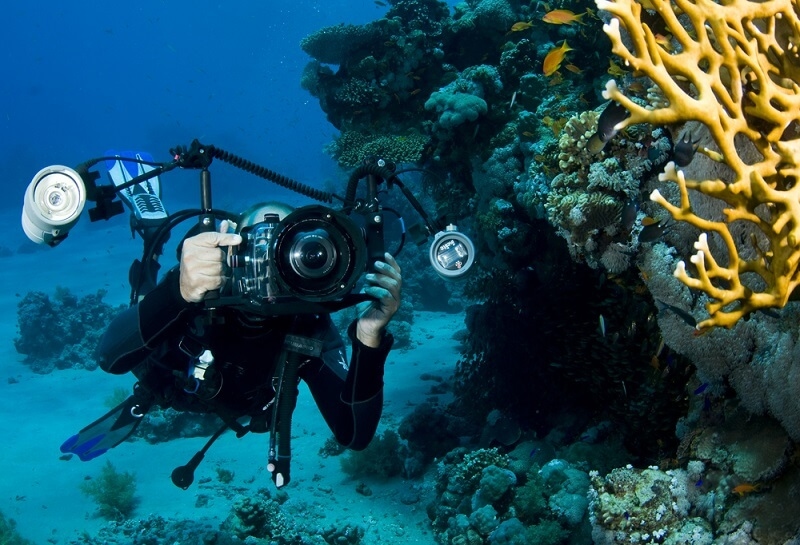
One of the most exciting and challenging forms of visual art is underwater photography. Underwater photography combines the technical skills of photography with the excitement of diving. Whether you are snorkeling near a shallow reef or diving in deeper water, it is invaluable to have a working understanding of taking photos with waterproof camera gear and lighting underwater to capture the breathtaking beauty of marine ecosystems.
This guide will show you how to shoot marine life, edit photographs underwater, dive safely for underwater photographers, and much more, to produce amazing underwater images that tell stories and reflect your awe-inspiring adventures beneath the ocean.
Underwater photography reveals the hidden treasures of the ocean. From colorful coral gardens to mysterious shipwrecks, underwater still and/or video portray a world that is generally unseen. However, water modifies the way light behaves—it absorbs color, lowers contrast, and changes sharpness.
Thus, it takes some time and practice to fully comprehend the technical and creative aspects of any underwater photography method. With the right gear, lighting, and understanding of safety protocols, you can share your underwater experiences with a gallery of amazing images.
The foundation of every successful underwater photography experience is having solid waterproof camera equipment. Your gear should withstand pressure, not leak, and be capable of producing clear images, even under stressful conditions.
Necessary gear includes:
Always test your waterproof camera gear in shallow water to ensure that seals and buttons function correctly. Performing regular maintenance and cleaning will extend the life and reliability of your gear.

One of the most critical aspects of underwater photography is learning how to use light effectively underwater. Upon descent, you will notice colors fading—the first color to disappear will be red, then orange, and then yellow. This is caused by light being absorbed and scattered by water particles.
Tips for better lighting while underwater:
Having good lighting will help bring out surface texture, brilliant colors, and definition in your underwater photos. These pieces of advice will help you transform ordinary underwater photos into vibrant, captivating images of marine life.
Photographing marine life takes patience, timing, and responsibility. The purpose is more than just taking a photograph; it's capturing natural behavior without disturbing the aquatic life or its habitat.
Guidelines to follow when photographing marine life:
When photographing marine life, the ethical photographer will do their part to protect the ecosystem and to capture authentic, compelling images that portray life below the surface.
The top concern for underwater photography should always be safety. Ensuring that diving safety management is taken care of allows you to be creative and not worry about safety.
Important safety tips:
If you are trained and practiced in diving and have proper training in camera skills, your safety will be enhanced, and your resultant photography will also improve.
While underwater, the same composition principles apply, but you must adapt to the fluid environment. Movement, light, and marine life all play roles in how you frame your shots.
Composition tips to remember:
Combining thoughtful composition with technical precision brings emotion and narrative to your underwater photos.
Post-processing plays a vital role in editing underwater photos, as raw images often appear blue-tinted or dull due to the absorption of light by the water. With careful adjustments, you can restore natural colors and highlight the details that make your photos stand out.
Editing steps to enhance your images:
Whether using Lightroom, Photoshop, or mobile apps, editing underwater photos allows you to achieve the visual impact your camera couldn’t fully capture underwater.
Proper maintenance of your underwater camera equipment enables it to perform optimally and last for a long time. If you don't take care of your equipment after your dive, it may experience rust or mechanical failure.
After every dive:
Regular maintenance saves money on repairs and ensures a smooth next dive session.
Underwater photography requires both creativity and technical skill. Because underwater subjects are constantly changing, there are infinite possibilities for creativity.
Try these ideas:
Combining creativity with technique will establish a style that ultimately differentiates your underwater portfolio.
As underwater photographers, we have a responsibility to protect the marine environments we capture. Ethical practices ensure future generations can also enjoy and document the ocean’s beauty.
Ways to stay eco-conscious:
Your work as an underwater photographer can inspire others to appreciate and protect the ocean.
Underwater photography blends art, adventure, and environmental awareness. By mastering waterproof camera gear, perfecting underwater lighting, adhering to diving safety protocols for photographers, and refining the editing of underwater photos, you can capture the awe-inspiring beauty of the ocean while preserving its delicate balance for future generations.
This content was created by AI